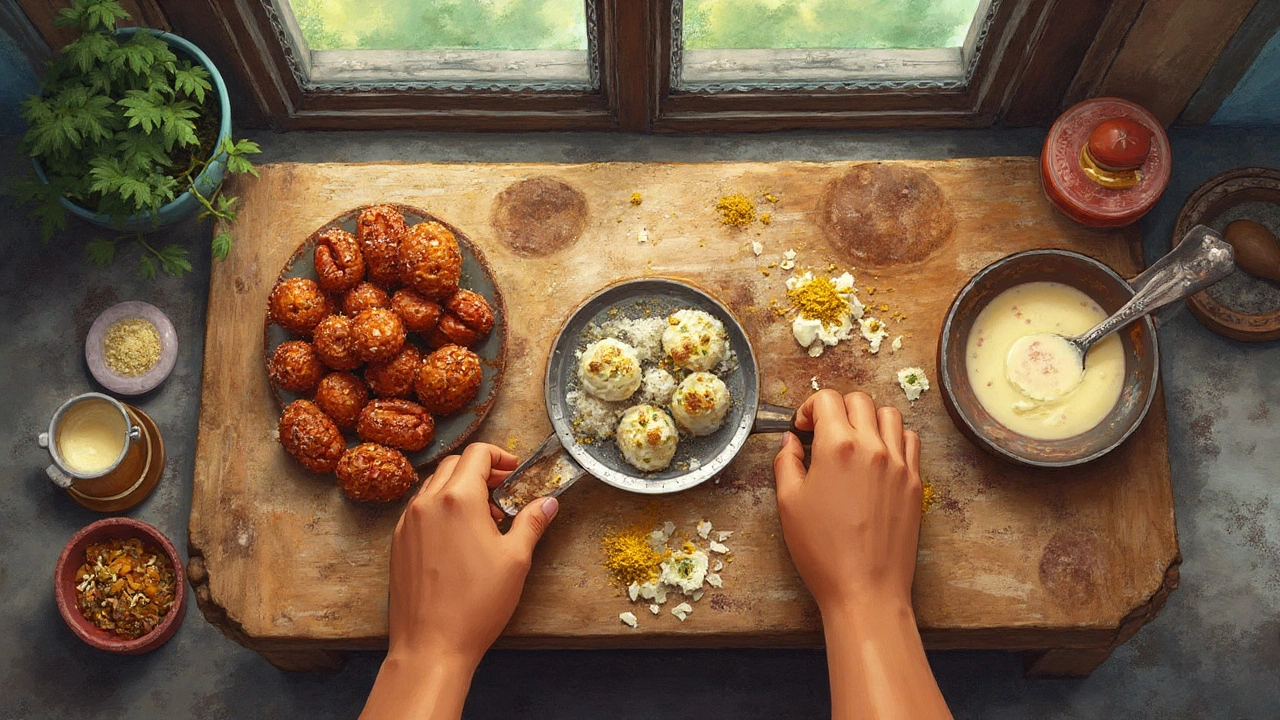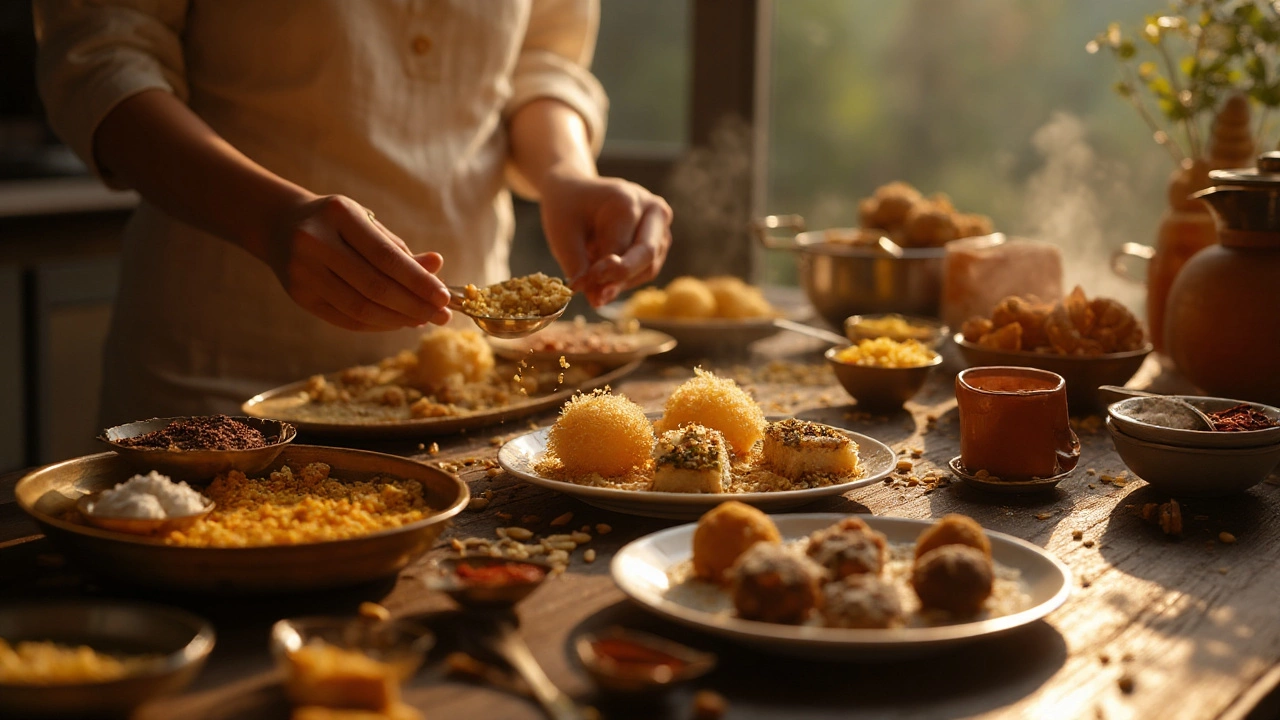16 Sep 2025
- 0 Comments
If you’re asking which Indian sweet is healthy, you probably want a straight answer before cravings win. Here it is: no mithai is a free-for-all, but a few are genuinely lighter and kinder on blood sugar when you watch portion size. Think fresh chenna-based sweets (sandesh, well-squeezed rasgulla), simple nut sweets (small kaju katli), date-nut laddoos, and sesame chikki. Expect balance, not miracles-sweets can fit if you match the pick to your goal and stick to a small piece.
- Top picks: sandesh, well-squeezed rasgulla, small kaju katli, date-nut laddoo, sesame (til) chikki.
- Portion rule: 1 small piece (20-30 g), aim ~100-150 kcal; stop at one.
- Healthier = lower added sugar, more protein/fiber, less saturated fat, and real satiety.
- Jaggery vs sugar: similar glycemic hit; choose for taste and minerals, not because it’s “diet.”
- Diabetes? Go for sandesh/rasgulla (portion-controlled) or 1 small date-nut ball; test your glucose response.
How to judge a “healthy” Indian sweet without fooling yourself
You don’t need a lab. Use this quick 4S test: Sugar, Saturated fat, Satiety, Size. Keep all four in check, and you can enjoy mithai without the post-sugar slump.
- Sugar: Less added sugar beats fancy sugars. Jaggery, coconut sugar, honey-they all count as free sugars. WHO and India’s ICMR-NIN advise keeping free sugars under 10% of daily energy (5% is even better). For most adults, that’s roughly 25 g a day as a smart upper target.
- Saturated fat: Ghee is delicious but dense. Keep ghee-heavy sweets (gulab jamun, mysore pak) as festival-only treats.
- Satiety: Protein or fiber helps you stop at one piece. Milk solids (paneer/chenna), nuts, sesame, and dates add staying power.
- Size: A “small” mithai is 20-30 g. If it’s the size of a golf ball, it’s probably two servings.
What actually makes a sweet “healthier” for most people?
- Protein up, sugar down: Sweets with milk protein (sandesh) or nuts (kaju/almond) hit better macros than syrup-soaked, deep-fried ones.
- Lower glycemic load (GL): GL looks at both carb amount and GI. A small serving with fewer total carbs usually matters more than chasing the perfect GI number.
- Minimal deep-frying: Oil/ghee plus sugar syrup is a double whammy. If it swims in syrup or oil, treat it as occasional.
What do authorities say? The Australian Dietary Guidelines and FSANZ echo the same principle as WHO: limit free sugars and saturated fat. The American Diabetes Association (2024) suggests counting carbs and focusing on overall patterns rather than “diabetic sweets.” India’s ICMR-NIN pushes the same message: traditional treats are fine in moderation, not as daily snacks.
Quick reality checks:
- Jaggery vs sugar: Glycemic index is similar. Jaggery has a touch of minerals, but that doesn’t cancel the glucose spike. Enjoy it for flavor, not health halos.
- “Sugar-free” sweets: Many use maltitol or other polyols. They can still raise glucose (less than sugar) and often cause bloating. Check total carbs, not just “sugar: 0 g.”
- Ghee isn’t “bad,” but it’s dense. A little ghee can improve flavor and portion control, but a lot makes the calorie math brutal.

The healthiest Indian sweets ranked by common goals
Different goals, different winners. Pick based on what you need today.
Best for weight-conscious eaters
- Sandesh (fresh, lightly sweetened): Milk protein, light sugar. One small piece (25 g) is satisfying without a sugar bath.
- Rasgulla (well-squeezed): Drain that syrup. Eat one small ball. You get volume and protein with less sugar if you squeeze it well.
- Kaju katli (thin slice): Energy-dense, so keep it tiny. Nut fats bring satiety; one 15-20 g piece can do the job.
Best for steadier blood sugar
- Sandesh and well-squeezed rasgulla: Lower carb per bite than syrupy or flour-based fried sweets. Pair with a protein-forward meal.
- Date-nut laddoo (small): Dates have a moderate GI, but the nuts reduce the overall glycemic load. Keep it to a mini ball.
- T il (sesame) chikki: Sesame plus jaggery-still sugar, but the fat and protein in sesame slow the spike. Break off a small shard.
Best for nutrient density
- Almond/badam or pistachio barfi (lightly sweet): Vitamin E, magnesium, and some protein. Portion is everything.
- Til chikki: Calcium, iron, and healthy fats from sesame.
- Coconut laddoo (with restrained sugar): Adds fiber and MCTs; still calorie-dense-keep it small.
Ones to reserve for special occasions
- Gulab jamun, jalebi, balushahi, mysore pak: Very high in sugar and/or saturated fat. Amazing, but best as a once-in-a-while treat.
Here’s a rough nutrition snapshot per small piece. Values vary by recipe, size, and how you squeeze/drain syrup. Use this as a guide, not a lab report.
| Sweet (approx. 1 small piece) | Calories (kcal) | Carbs (g) | Sugars (g) | Fat (g) | Sat fat (g) | Protein (g) | Fiber (g) | GI est. | GL est. |
|---|---|---|---|---|---|---|---|---|---|
| Sandesh (25 g) | 80-95 | 8-10 | 6-8 | 3-4 | 2 | 3-4 | 0 | 40-50 | 3-5 |
| Rasgulla, well-squeezed (30 g) | 70-90 | 9-11 | 7-9 | 1-2 | <1 | 2-3 | 0 | 45-55 | 4-6 |
| Kaju katli (20 g thin) | 95-110 | 8-10 | 7-9 | 5-7 | 1 | 2-3 | 1 | 40-50 | 3-5 |
| Date-nut laddoo (18 g mini) | 85-100 | 10-12 | 8-10 | 4-5 | 0.5 | 2-3 | 2-3 | 40-50 | 4-6 |
| Til (sesame) chikki (15 g shard) | 80-95 | 9-11 | 8-10 | 4-6 | 0.7 | 2-3 | 1-2 | 45-55 | 4-6 |
| Besan laddoo (25 g) | 120-140 | 10-12 | 8-10 | 7-9 | 3-4 | 3-4 | 1-2 | 45-55 | 5-7 |
| Gulab jamun (1 small) | 160-190 | 22-25 | 16-18 | 6-8 | 3-4 | 3 | 0 | 60-70 | 13-16 |
| Jalebi (1 small coil) | 150-180 | 25-30 | 20-24 | 5-6 | 2 | 2 | 0 | 65-75 | 16-20 |
Reading the table: if you want the best odds of keeping energy and glucose in check, sandesh and squeezed rasgulla are safe bets. Small kaju katli and mini date-nut balls are fine if you’re strict with size. Jalebi and gulab jamun are celebration sweets.
Portion cheat-sheet:
- Everyday-ish: 1 small sandesh or squeezed rasgulla, after a protein-rich meal.
- Twice a week treat: 1 thin kaju katli or 1 mini date-nut ball.
- Festival only: gulab jamun, jalebi, mysore pak-enjoy, then return to baseline.
Smart pairing: Eat sweets after a balanced meal with protein and veg, not on an empty stomach. A post-meal walk helps glucose control more than you’d think-Aussie and global studies keep showing the impact of light movement after carbs.

Make-or-buy: quick healthier recipes, label hacks, and a handy checklist
If you like to cook, these quick tweaks give you control. If you’re buying from a shop or supermarket in Australia, label reading is your best friend.
10-minute date-nut laddoo (no added sugar)
- Pulse 1 cup soft Medjool dates (pitted) with 1 cup mixed nuts (almond, pistachio, cashew). Add 1 tbsp sesame or chia for bonus fiber.
- Flavor with cardamom, a pinch of salt, and a few drops of rose water or vanilla.
- Roll into 12 mini balls (about 18 g each). Lightly dust with desiccated coconut or cocoa.
- Portion: 1 mini ball. Store chilled. These sit around 85-100 kcal each with fiber and decent satiety.
Heuristic: Use a 2:1 nut:date ratio if you’re watching carbs; a 1:1 ratio if you want them sweeter and softer.
Light sandesh (fresh chenna, low sugar)
- Make fresh chenna: simmer 1 L milk, add 2 tbsp lemon juice, curdle, strain, rinse, and press dry.
- Blend chenna till smooth with 2-3 tsp sugar or stevia/erythritol to taste, cardamom, and a tiny pinch of salt.
- Cook gently in a non-stick pan 2-3 minutes to remove wetness. Cool.
- Mould small pieces, garnish with a sliver of pistachio.
Tip: Don’t overcook or it goes grainy. This version gives you milk protein with far less sugar than shop sweets.
Sesame (til) jaggery chikki, thinner and lighter
- Dry-roast 1 cup sesame till nutty. Warm 3/4 cup powdered jaggery with 1-2 tbsp water till it reaches a soft ball stage (drop in cold water; it forms a soft ball).
- Stir in sesame, a pinch of salt, and 1 tsp ghee. Spread very thinly between two sheets and roll flat.
- Cut into small shards (about 15 g each). One piece is a nice sweet, crunchy finish.
Buying smarter in Australia:
- Check ingredients list: Avoid “hydrogenated vegetable fat/shortening.” You want ghee or non-hydrogenated oils.
- Per 100 g panel: aim for lower total sugars and saturated fat. If sugar sits first on the list, it’s a signal to downsize portion.
- “No added sugar” often means dates or polyols. Look at total carbs and sugar alcohols. Polyols can upset your gut in higher amounts.
- Allergens: Many sweets include nuts and dairy; vegan or lactose-free versions exist, but confirm labels.
Practical checklist to keep sweets in your life (without the guilt hangover)
- Set a target: one small piece (~100-150 kcal).
- Eat it after a meal, not as a solo snack.
- Prefer protein/fiber: milk-based or nut/sesame-based beats flour + syrup.
- Mind the syrup: squeeze rasgullas; dab extra syrup off other sweets.
- Walk 10-15 minutes after. It helps your glucose and mood.
- Store treats out of sight; plate just one.
Mini-FAQ
healthy Indian sweets is the core topic here, so let’s address the usual curveballs.
Is jaggery healthier than white sugar?
Not for blood sugar. Both add similar glucose load. Jaggery brings trace minerals, but in tiny amounts at realistic portions. Pick based on taste and recipe, not for a health pass.
Are sugar-free mithai better for diabetes?
Sometimes. Polyol-sweetened sweets can reduce sugar grams, but total carbs may still be high, and some polyols raise glucose a bit. Many also cause bloating. If you use stevia/erythritol at home, you control the carbs better.
Is ghee in sweets a problem?
It’s about dose. Small amounts add flavor and can help you stop at one. Large amounts drive calories and saturated fat up fast. Aim for sweets where fat supports satiety, not where it’s the main ingredient.
Best pick if I lift weights?
Light sandesh after dinner gives you protein with modest sugar. A mini date-nut ball can work pre-workout for quick energy.
Gluten-free or vegan options?
Many mithai are naturally gluten-free. Vegan: date-nut laddoos, sesame chikki, coconut laddoo (with plant milk). Check labels for ghee and milk solids.
What about kids?
Go for smaller pieces and sweets with nuts or milk protein for satiety. Avoid syrup-soaked, dyed, or heavily fried items for regular treats.
Next steps by scenario
- Diabetes or prediabetes: Choose sandesh or squeezed rasgulla; keep to one small piece after a meal; take a 10-minute walk; check your meter to see your personal response. ADA (2024) focuses on total carbs and patterns-this fits.
- Weight loss: Plan sweets on active days. Pick sandesh or mini date-nut laddoo. Use the “3-bite rule” for anything richer: 3 slow bites, stop.
- Athlete or highly active: Time sweets around training. Date-nut ball pre-session; sandesh post as protein + quick carbs.
- Festival host: Offer smaller pieces, add fruit and nuts to the table, and keep water or chai around. People naturally eat less when choices aren’t only syrupy.
Bottom line for the exact question “Which Indian sweet is healthy?”-if you want the safest, broadly helpful answer, pick sandesh first. A well-squeezed rasgulla is close behind. If you love nuts, a thin kaju katli or mini date-nut laddoo works, as long as you stick to one tiny piece. That’s the sweet spot-pun intended.
References you can trust: WHO sugar guidance (2015, still current), ICMR-NIN dietary guidelines for Indians, Australian Dietary Guidelines and FSANZ nutrient advice, and the ADA Standards of Care 2024. They all converge on the same idea: keep free sugars and saturated fat low, eat sweets with intent, and move your body after meals.
